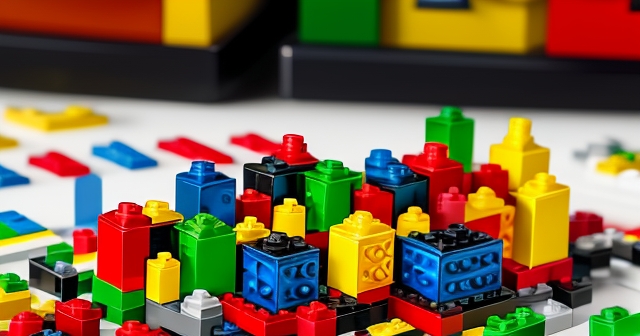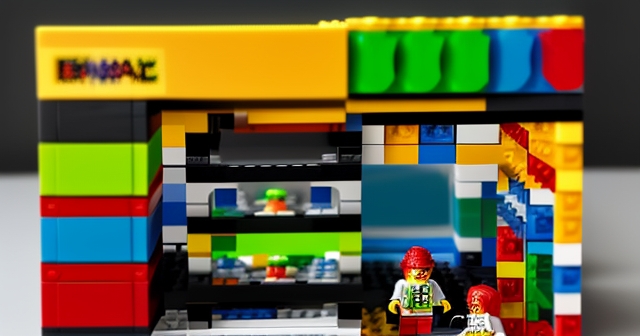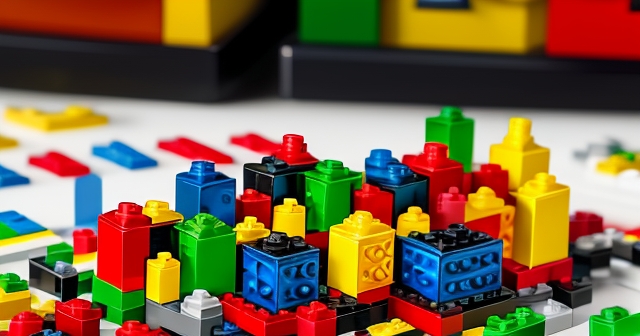Understanding “Money Legos”: More Than Just Toys in the Financial World
When you hear the name LEGO, you likely picture colorful plastic bricks, intricate sets, and the boundless creativity of childhood play. Indeed, for generations, LEGO has been synonymous with imagination. But step beyond the playroom, and you’ll discover that the world of LEGO is far more complex, intertwining significant corporate finance, unexpected asset value, controversial public spending, and even organized crime. Welcome to the multifaceted realm of “money Legos.”
In this exploration, we will delve into the financial underpinnings of The LEGO Group’s remarkable success, examine how individual sets have transitioned from mere playthings to valuable assets, and navigate the surprising and sometimes contentious ways these popular bricks intersect with public funds and illicit markets. As we analyze these various facets, you’ll gain insight not just into a single company, but into broader concepts of value, investment, market dynamics, and policy implications, framed through the lens of these familiar plastic pieces. Think of it as building your understanding of complex financial and societal structures, one brick at a time.

In recent years, LEGO has seen a significant rise in its market presence and asset values. Here are some insights into this trend:
- Bricks have become symbols of wealth and investment, often seen as alternative assets in collectible markets.
- Demand for specific sets can drive prices to thousands of dollars in secondary markets.
- Educational initiatives have sparked new interests in LEGOs, further expanding their relevance and financial implications.
The Bricks of Success: Decoding The LEGO Group’s Record Financial Performance
Let’s begin by examining the core business itself: The LEGO Group. In a world grappling with economic uncertainty and shifting consumer habits, how has a toy company managed to not only survive but thrive, achieving what they themselves describe as “record financial results”? For any investor or business analyst, understanding this trajectory offers valuable lessons in resilience, strategy, and execution.
In their reporting for fiscal year 2024 and the first half of 2024, The LEGO Group presented compelling numbers. We saw reported double-digit growth figures that significantly outpaced the broader toy market, which in fact experienced a slight decline. Specifically, their revenue grew by 13% for the full year and a robust 26% in the first half, while operating profit saw a 10% rise for the year and an impressive 26% jump in the first half. These aren’t just abstract percentages; they represent billions of Danish Krone (DKK) flowing into the company coffers, driven by strong consumer demand.

Consider what this implies: even when the overall market for toys is shrinking, The LEGO Group is expanding its footprint and increasing sales. This suggests a powerful brand, effective marketing, and products that resonate deeply with consumers, prompting them to spend even when discretionary budgets might be tight. We’re not just seeing growth; we’re seeing significant market share gains in key regions like the Americas, Europe, and the Middle East. This isn’t accidental; it’s the result of deliberate strategic choices.
Here’s a summary of LEGO’s financial performance:
| Period | Revenue Growth | Profit Increase |
|---|---|---|
| Full Year 2024 | 13% | 10% |
| First Half 2024 | 26% | 26% |
Outperforming the Market: What Drove LEGO’s Remarkable Growth?
So, what factors underpinned this exceptional performance? The company points to several key drivers, offering insights that are relevant to analyzing success in any industry. First and foremost is the strength and diversity of their product portfolio. Think about the range: from evergreen themes like LEGO City to licensed blockbusters like Star Wars and Harry Potter, plus innovative new ventures like LEGO Fortnite and sophisticated lines like LEGO Icons and Botanical Collection. This breadth ensures they appeal to a vast demographic, from young children to adult enthusiasts.
But a great product line is only part of the equation. Execution matters. The LEGO Group emphasizes strong retail partnerships and effective e-commerce strategies. In today’s multi-channel retail environment, meeting consumers where they are – whether in traditional brick-and-mortar stores like Target and Walmart, or online via Amazon and their own platforms – is crucial. Their ability to manage complex global supply chains and logistics also plays a vital role in ensuring products are available when and where customers want them.

We also see the impact of strategic partnerships, such as those with NIKE, Inc. and Formula 1®, which extend the brand’s reach beyond traditional toy aisles into areas like fashion and sports. These collaborations create buzz and attract new segments of consumers, reinforcing the brand’s cultural relevance. Ultimately, The LEGO Group’s ability to combine diverse, appealing products with effective market execution is a masterclass in business strategy, allowing them to capture consumer spending even in a challenging economic climate.
Building Capacity: LEGO’s Strategic Investments for the Future
Examining a company’s profitability is essential, but looking solely at current earnings provides an incomplete picture. Savvy investors also scrutinize strategic spending and capital investments, which indicate a company’s confidence in its future and its plans for long-term growth. The LEGO Group’s financial reports reveal significant investments aimed at building capacity and enhancing operations globally.
Despite posting strong profits and generating healthy free cash flow (DKK 10.2 billion for the full year, DKK 3.0 billion for the first half), the company isn’t hoarding capital. They are actively deploying it into major projects. This includes expanding existing manufacturing facilities and building brand new factories in key regions. For example, major construction is underway on new sites in Vietnam and the United States (specifically in Virginia), while existing factories in Mexico, Hungary, and China are also being expanded. Why is this happening? It’s about increasing production capacity to meet growing global demand and optimizing their supply chain to be closer to core markets, reducing transit times and costs.
Beyond physical infrastructure, The LEGO Group is also accelerating investments in digital transformation and technology. In an increasingly connected world, digital capabilities are not optional; they are foundational to everything from e-commerce to supply chain management and product innovation. These investments are about ensuring the company remains agile and efficient in a rapidly evolving technological landscape. When we see a profitable company reinvesting heavily like this, what does it tell us about their long-term vision and commitment to sustained growth?

Greening the Future: LEGO’s Sustainability Commitments
In addition to expanding physical and digital infrastructure, The LEGO Group is also directing significant resources towards its sustainability agenda. This isn’t just a compliance exercise; it’s becoming an increasingly important part of corporate strategy, influencing everything from material sourcing to brand reputation and consumer choice. For a company whose products are made from plastic, addressing environmental impact is particularly crucial.
The company has significantly increased its purchasing of certified mass balance materials, which is a system that tracks sustainable materials through complex supply chains. While the final product might still contain traditional plastic, the mass balance principle ensures that an equivalent amount of sustainable material (from renewable or recycled sources) has been purchased and entered the system. This is a tangible step towards reducing their reliance on virgin fossil fuels and transitioning to more sustainable materials. Their commitment to tripling spending on sustainability in the short term underscores the seriousness of this effort.
Furthermore, efforts are underway to reduce carbon emissions, specifically greenhouse gas emissions, across their value chain. They are also expanding initiatives like LEGO Replay, which encourages consumers to donate used bricks for redistribution. These sustainability initiatives align with broader global corporate trends and are increasingly important for attracting environmentally conscious consumers and investors. They demonstrate a commitment to building not just physical products, but a more responsible and sustainable business model.
Beyond Playthings: When LEGO Becomes a Valuable Asset Class
Now, let’s shift our perspective from the corporate balance sheet to the individual brick. While most LEGO sets are bought to be played with, a fascinating phenomenon has emerged: certain sets, particularly retired or limited-edition ones, have become highly sought-after collectibles, commanding significant sums on the secondary market. This transforms them from simple toys into tangible assets with real monetary value, sometimes appreciating significantly over time.
We’re talking about sets like elaborate Star Wars models (such as the UCS Super Star Destroyer, which originally retailed for around $400 and can now fetch well over $2,000), massive builds like the LEGO Titanic (a $680 set), or detailed castles from the Harry Potter theme. These aren’t impulse buys; they are substantial purchases, often costing $500, $900, or even $1800 for a single set. This high price point and potential for appreciation attract a different kind of interest – one that has nothing to do with play.
For collectors and enthusiasts, these sets represent a passion, a form of investment, and sometimes, a source of significant personal wealth. The value is driven by rarity, demand, condition (especially if unopened), and the emotional connection to popular themes. But this rising value has an unfortunate consequence: it makes these desirable plastic bricks a target for individuals and organizations looking to profit through less legitimate means.

The Dark Side: Organized Retail Theft and LEGOs
The increasing asset value of certain LEGO sets has unfortunately drawn the attention of organized retail theft rings. These aren’t just teenagers shoplifting; these are sophisticated operations that target high-value items from major retailers like Target, Fred Meyer, Barnes & Noble, Walmart, and others, stealing them in bulk to resell for cash.
News reports highlight instances where millions of dollars worth of goods, including vast quantities of LEGO sets, have been stolen in this manner. The scale of operation is often substantial, involving coordinated efforts across multiple stores and individuals. The stolen merchandise is then allegedly fenced, sometimes through seemingly legitimate businesses, or sold online, generating significant illicit income. Authorities have conducted busts recovering large hauls, sometimes valued at hundreds of thousands of dollars from a single operation.
This phenomenon underscores how the lines between a consumer product and a liquidable asset can blur, creating new challenges for retailers and law enforcement. It highlights how value, once established, can attract opportunistic behavior across different parts of the economic spectrum. The fact that specific items like LEGO sets are being targeted at this scale is a testament to their recognized value beyond their intended use.
Policing the Bricks: Law Enforcement’s Response to LEGO Crime
Given the scale and organization of these theft rings, law enforcement agencies are actively involved in trying to curb “LEGO crime.” Police departments, sometimes with specialized retail crime units, are tracking these operations, investigating thefts, and attempting to intercept stolen merchandise. Recoveries often involve significant quantities of sets, sometimes found in storage units, vehicles, or illicit warehouses.
Beyond organized retail theft from large stores, there have also been instances of burglaries specifically targeting smaller, specialty LEGO stores. These stores, which often deal in rare, retired, and highly valuable sets, are seen as repositories of concentrated wealth in the LEGO world. Reports detail burglaries where tens of thousands of dollars worth of rare sets were specifically targeted and stolen, suggesting the perpetrators had detailed knowledge of the market value of these items.
The involvement of law enforcement in recovering millions of dollars worth of stolen LEGO merchandise might seem unusual at first glance, considering they are toys. However, when viewed through the lens of their asset value and the scale of organized crime involved, it becomes clear that this is a significant economic issue with real consequences for businesses and consumers (potentially leading to higher prices to offset losses). It’s a stark reminder that value, in whatever form it takes, can attract unwelcome attention.
Public Purse Strings: LEGOs in Education Voucher Programs
Moving from the criminal realm to the public sphere, LEGOs have also become an unexpected focal point of debate surrounding the use of public funds, specifically within state-level education voucher programs. These programs, often designed to give parents more choice in their children’s education, sometimes allow for the use of public money for educational materials and services beyond traditional school tuition.
One prominent example, cited in recent reports, comes from Arizona’s Empowerment Scholarship Accounts (ESA) program. Data revealed that over a nine-month period, more than $1 million in public funds distributed through this program was used to purchase LEGO sets. This figure immediately sparked controversy and raised questions about how taxpayer money is being spent and what qualifies as a legitimate “educational expense” within the context of such programs.
| Example of High-Value LEGO Purchases | Cost |
|---|---|
| UCS Super Star Destroyer | $400 original | $2000 current |
| LEGO Titanic | $680 |
The debate intensified when it was reported that some of these purchases included high-value, expensive sets – the very same types of sets that are attractive targets for collectors and thieves due to their cost. Parents participating in the program argue that LEGOs are valuable educational tools, promoting creativity, problem-solving, and STEM skills. However, critics question whether spending public money on costly collector sets truly aligns with the program’s educational goals, especially when oversight mechanisms appear to be lacking or unclear.
The Arizona Debate: Oversight and Educational Expenditure
The controversy in Arizona highlights a fundamental tension within education voucher programs: balancing parental choice with public accountability. While programs like ESA are designed to empower parents, they also involve the expenditure of taxpayer money, which traditionally comes with expectations of oversight and justification.
State officials and advocacy groups hold differing views on the issue. Some, like Arizona’s Superintendent of Public Instruction, have expressed concerns about the lack of detailed tracking and justification for specific purchases like high-cost LEGO sets, suggesting potential abuse or at least questionable allocation of resources. Advocacy groups critical of voucher programs, like Save Our Schools (SOS), use these examples to argue for tighter regulations and greater transparency.
On the other hand, proponents of the ESA program and parental choice emphasize that parents are best equipped to decide what educational materials are suitable for their children. They view LEGOs, even expensive ones, as legitimate tools for hands-on learning. This divergence in perspective underscores the difficulty in defining the boundaries of “educational spending” when public funds are channeled directly to parents via vouchers, prompting questions about who is responsible for ensuring these funds are used appropriately and effectively according to the program’s intent.
Policy Implications: What the ESA Controversy Reveals
The debate over LEGO purchases in Arizona’s ESA program is not just a local peculiarity; it reflects broader national tensions and challenges inherent in the design and implementation of school choice and voucher programs. It raises critical policy questions that extend far beyond plastic bricks.
Firstly, it highlights the challenge of defining “educational expense” in a flexible voucher system. Should it be narrowly defined to curriculum materials and tuition, or broadly interpreted to include any resource a parent deems beneficial for learning? The LEGO example pushes this boundary, forcing a discussion about tangible versus intangible benefits and the cost-effectiveness of different learning tools. Secondly, it exposes potential weaknesses in oversight and accountability mechanisms. If millions can be spent on items that generate public scrutiny without clear justification or tracking, what does that say about the program’s design? Policy makers must grapple with how to ensure responsible spending while maintaining the flexibility that is often a core tenet of these programs.
Ultimately, the controversy serves as a case study in the complexities of public finance, educational policy, and the challenges of balancing individual autonomy with collective responsibility for taxpayer money. It prompts a deeper look at program rules, reporting requirements, and the public debate around school choice, using the seemingly innocuous LEGO brick as an unexpected catalyst for significant policy discussion.
Conclusion: The Complex Economy of Money Legos
As we conclude our exploration, it’s clear that the world of LEGO extends far beyond the simple act of connecting bricks. We’ve journeyed from the robust financial engine of a global corporation achieving record profits and making significant strategic investments, to the unexpected emergence of individual LEGO sets as valuable assets commanding high prices on the secondary market. We’ve seen how this value attracts the negative attention of organized crime, leading to large-scale theft and burglaries.

And finally, we’ve examined the surprising intersection of LEGOs with public finance, where their use within education voucher programs has sparked heated debate over educational spending, oversight, and policy design. Each facet reveals a layer of complexity, illustrating how a universally recognized consumer product can interact with diverse aspects of the financial world, market dynamics, legal systems, and public policy.
The story of “money Legos” is a compelling narrative about value creation, market forces both legitimate and illicit, corporate responsibility, and the ongoing challenges of public accountability. It reminds us that valuable assets come in many forms, that market success can have unintended consequences, and that even the most familiar objects can become central figures in complex financial and societal discussions. By understanding these different dimensions, you gain a richer perspective on the intricate ways commerce, value, and human behavior intertwine in the modern world.
money legosFAQ
Q:What are “money Legos”?
A:Money Legos refer to the idea that LEGO sets can hold significant value and are treated as assets in the financial market, beyond just toys.
Q:Why are LEGO sets considered valuable investments?
A:Some LEGO sets, especially retired or limited-edition ones, become collectibles that appreciate in value over time, making them attractive for investment.
Q:How do public spending policies involve LEGOs?
A:In some education voucher programs, public funds have been used to purchase LEGO sets, sparking debate about the appropriateness of such expenditures.
